Session 4: Chromosomal Abnormalities
1/68
There's no tags or description
Looks like no tags are added yet.
Name | Mastery | Learn | Test | Matching | Spaced |
|---|
No study sessions yet.
69 Terms
Describe the structure of a chromosome
Each chromosome consists of proteins and ONE long molecules of DNA.
Each chromosome consists of a short arm (p) and long arm (q) connected by a centromere
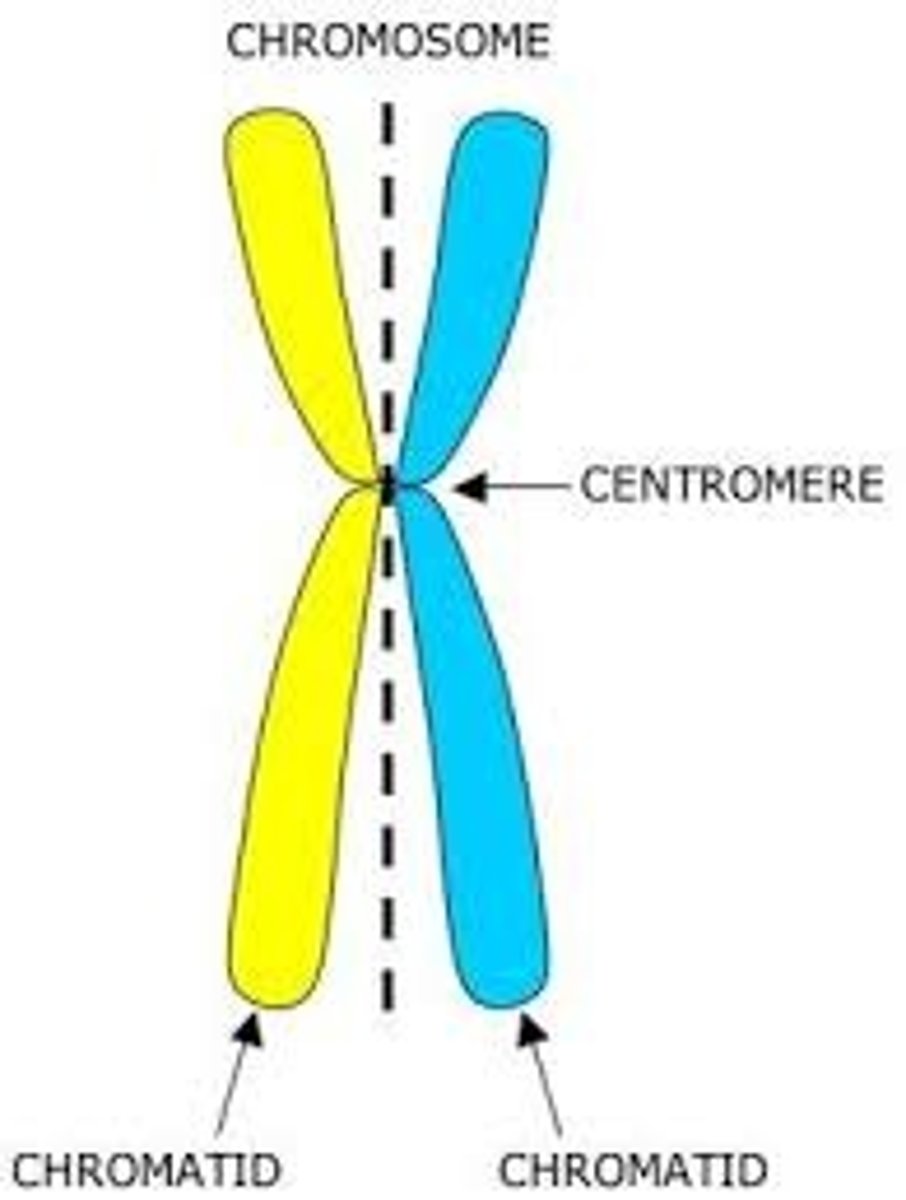
What is a chromatid?
One half of a duplicated chromosome
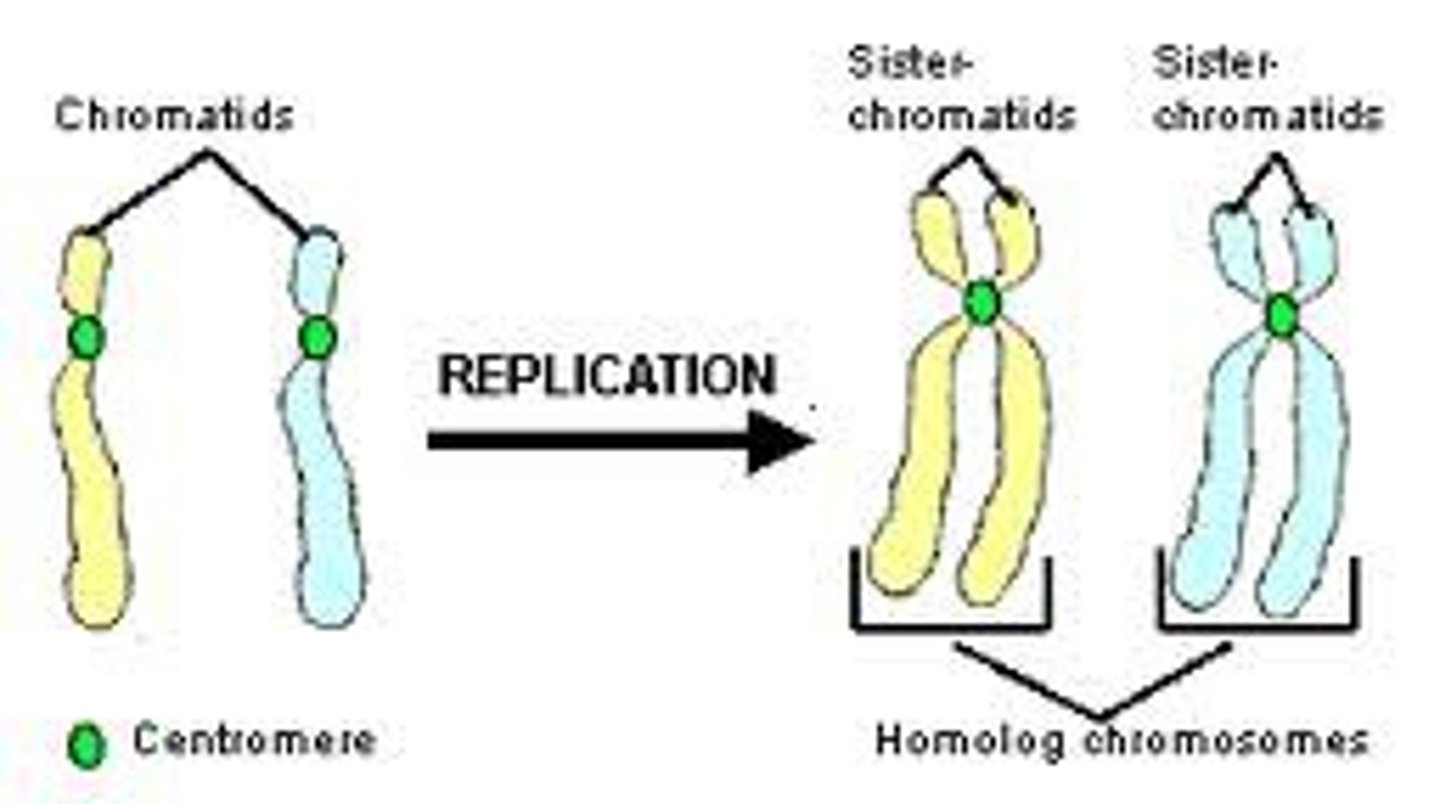
Why is it important that chromosomes replicate during the S phase BEFORE cell division?
So that each daughter cell receives a complete set of chromosomes
How many chromosomes are in each diploid cell in our body?
46 chromosomes in each diploid cell = 23 pairs
22 pairs of autosomes
1 pair of sex chromosomes
What is a karyotype?
Describes the number of chromosomes and what they look like (size bands, centromere placement).
What is a karyogram?
Study of the whole set of chromosomes arranged in PAIRS by size, and position of centromere
What is a chromosome ideogram? What stains can be used on condensed chromsosomes to produce a visible karyotype?
A graphical or schematic representation of chromosomes.
A Giemsa stain/G-banding can be used to produce a visible karyotype.
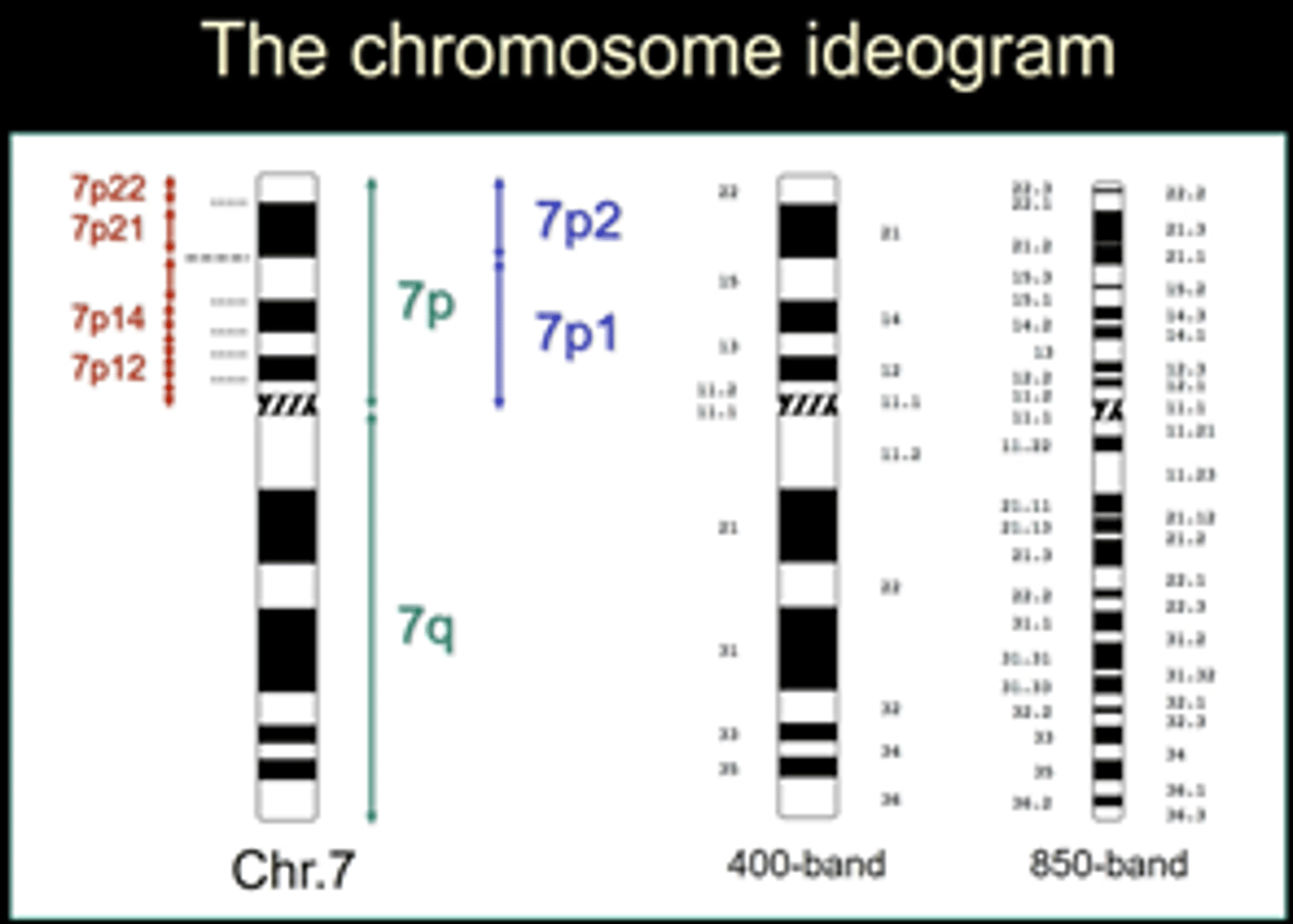
What is karyotyping?
The process of pairing and ordering ALL the chromosomes of an individual. Karyotypes are prepared from mitotic cells that have been arrested in the metaphase/prometaphase stage of the cell cycle (when chromosomes are MOST condensed).
Karyotyping is used to detect changes in...
1) Chromosome number
2) Structural chromosomal changes = deletions, duplications, translocations, inversions
Which tissue types can be a source of mitotic cells for karyotyping in adults?
Peripheral blood, skin biopsy, tumour biopsies or bone marrow samples (cancer)
How can prenatal diagnosis be carried out for karyotyping?
Amniocentesis or chorionic villus specimens used as source of cells
What are some indications (reasons) for karyotyping?
1. Prenatal screening = Down's syndrome (risk increases as mother ages >35), family history, abnormal ultrasound of foetus.
2. Birth defects (post-natal screening) = Malformations, mental/developmental impairments.
3. Abnormal sexual development = KLINEFELTER syndrome, TURNER syndrome
4. Infertility of the mother = recurrent foetal loss
5. Leukaemia and other cancers
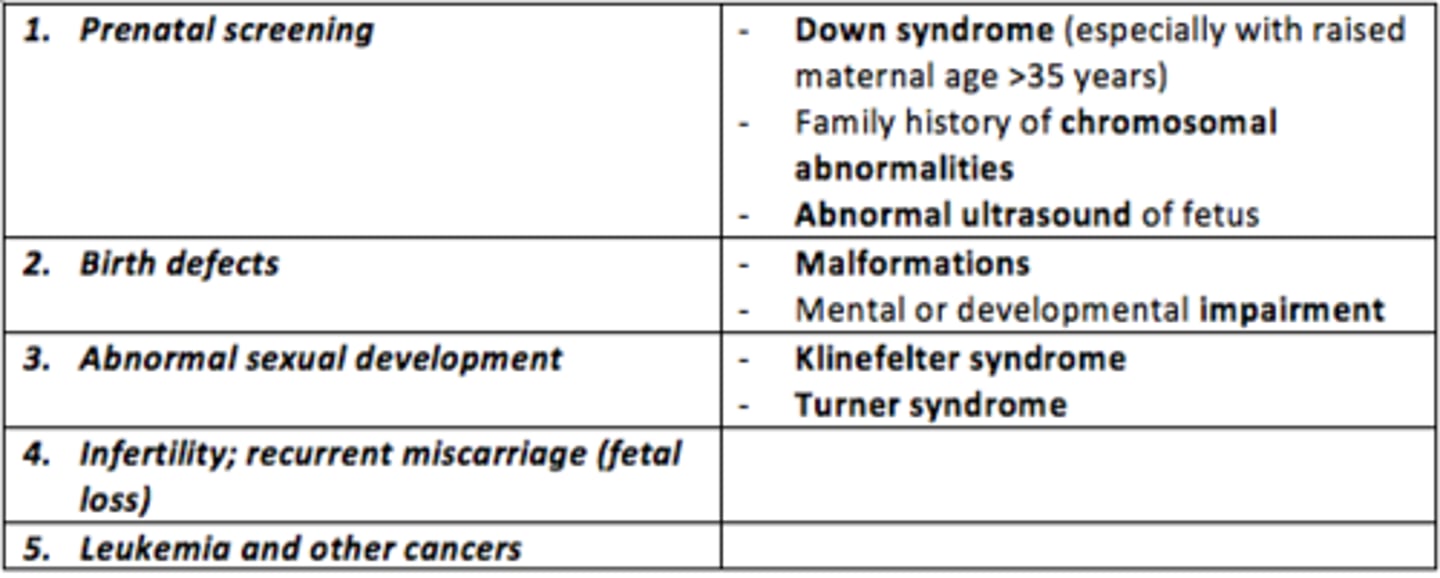
Report the normal female karyotype in standard format of karyotyping
46,XX
What are the three main types of chromosomal abnormalities?
1) Polyploidy
2) Aneupoloidy
3) Chromosomal mutations = deletions, duplications, inversion, insertion, translocation
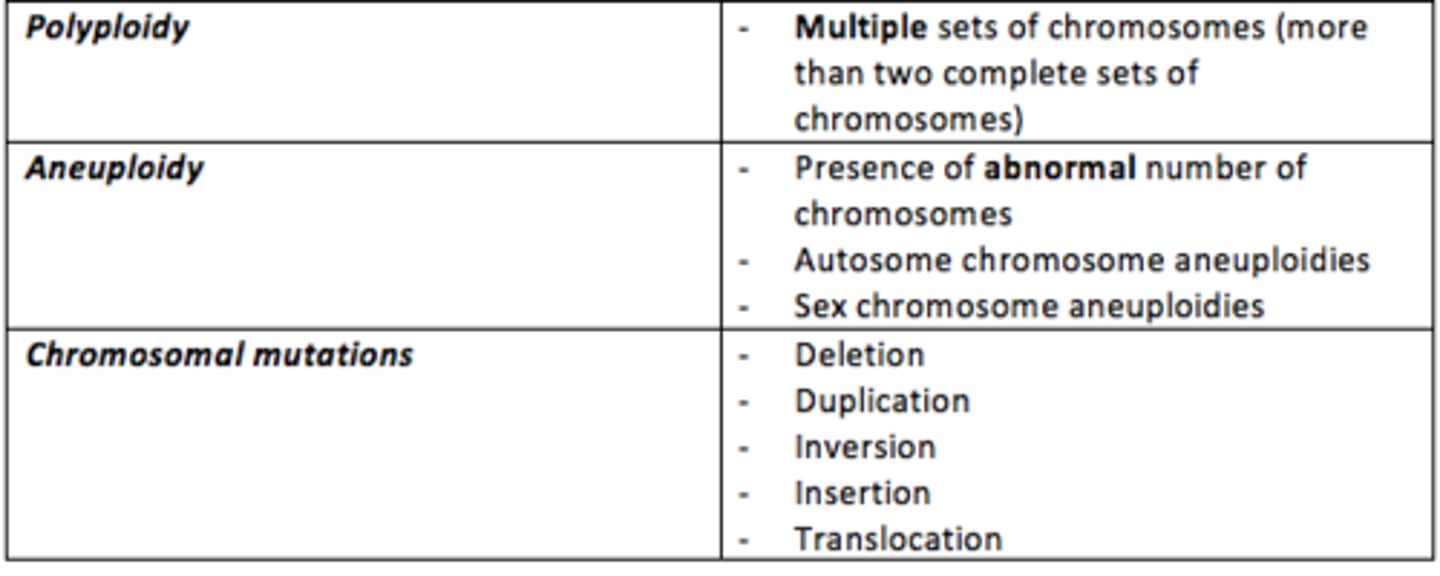
What are the main (subtle) structural chromosomal mutations?
Deletion, duplication, inversion, insertion, translocation
What is polyploidy?
Heritable condition of possessing more than two complete sets of chromosomes.
Types of polyploidy in humans
True polyploidy rarely occurs in humans (not viable = most triploid babies will miscarry or die in the first year of life)
- Triploidy = 69, XXX
- Tetraploidy = 92, XXXX
What is the most common cause of triploidy (a type of polyploidy in humans)?
Polyspermy (one oocyte fertilised by >1 spermatozoa)
What is aneuploidy?
Presence of an abnormal number of chromosomes in a cell: usually one more or one less.
What is the most common type of aneuploidy in humans?
Trisomies = 0.3% of all live births. Represent ~35% of spontaneous abortions.
What is the most common cause of aneuploidy?
Nondisjunction of chromosomes during meiosis (most often during maternal meiosis 1).

After what age do women have a sharp increase in the risk of trisomies? (risk factor)
The risk of trisomy increases sharply after age of 35.
Give examples of three trisomies in humans (autosomal aneupolodies)?
1. Trisomy 21: Down's syndrome
2. Trisomy 18: Edwards syndrome
3. Trisomy 13: Patau syndrome

What is one viable trisomy in humans?
Trisomy 21 - Down's syndrome
Why is trisomy 21 (Down's syndrome) viable?
Trisomy 21 is the only viable autosomal trisomy because the number of protein-coding sequences predicted for chromosome 21 is the smallest of any human chromosome.
What are the three causes of Down's syndrome?
1. Trisomy 21: ~95% of cases - more common in boys than girls (1.5 : 1).
2. Mosaic's Down's syndrome: rare form in which person only has SOME cells with extra copy of chromosome 21.
3. Translocation Down's syndrome: occurs when a portion of chromosome 21 becomes translocated to another chromosome before or after conception.

What are some common distinctive facial features of those with Down's syndrome (nenonates/adults)
- Flattened face
- Small head
- Short neck
- Protruding tongue
- Upwards slanting eyes: palpebral fissures
- Unusually shaped ears/small ears
- Hypotonia
What are some other characteristic common features of those with Down's syndrome?
- Broad, short hands with only SINGLE crease in palm
- Short fingers
- Small hands and feet
- Excessive flexibility
- Tiny white spots on the iris of the eye: brushfield's spots
- Short stature/height
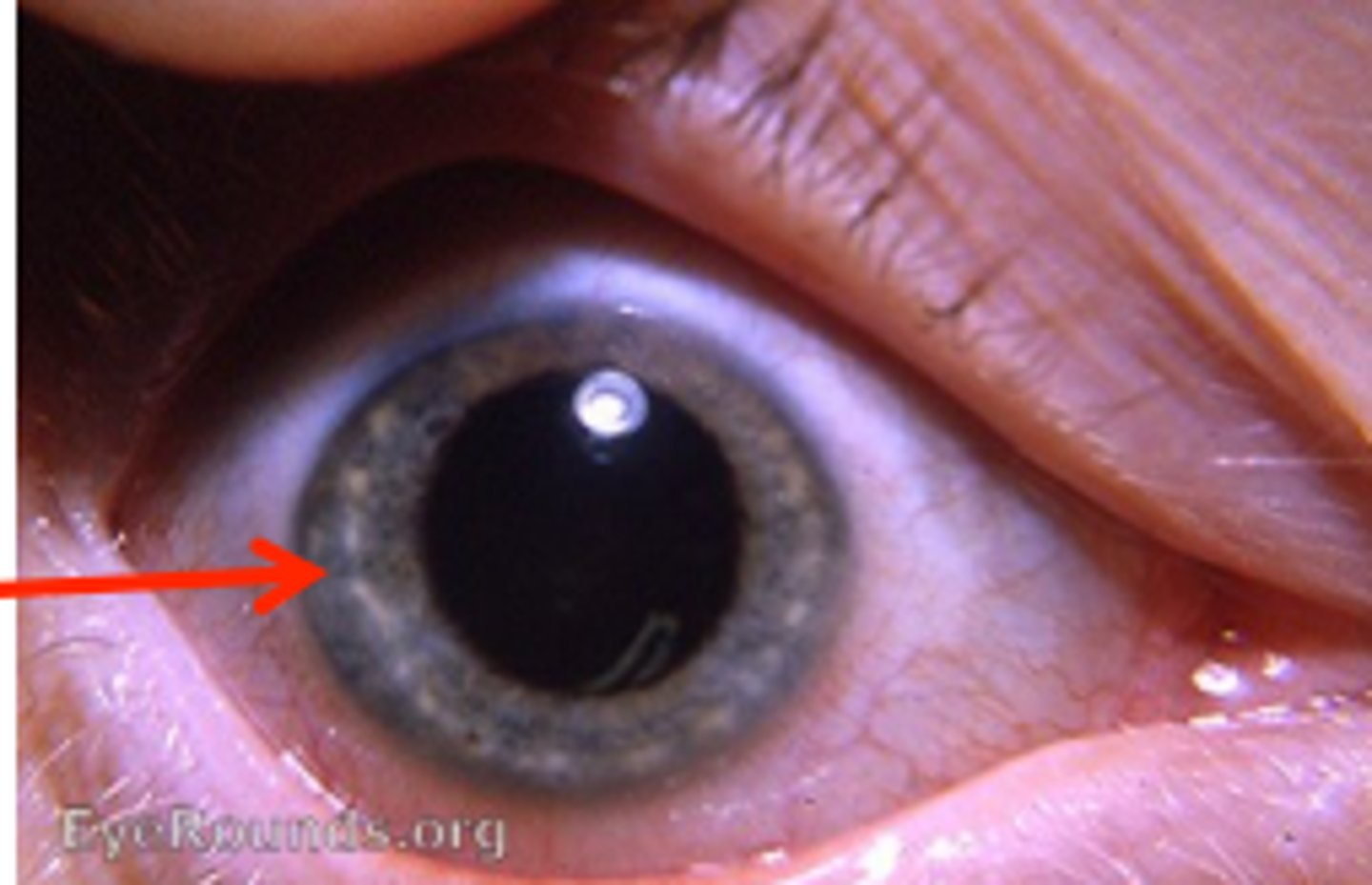
What are the symptoms of Down's syndrome?
- Mild-moderate intellectual disability
- Congenital heart disease
- Haematological malignancies more common (acute lymphoblastic leukaemia - 10x higher)
- Hypothyroidism
- Gastrointestinal: constipation due to less nerves in colon
- Infertility in men, reduced fertility in women
- Eye disorders: strabismus, cataracts, refractive errors
- Hearing disorders: 38-78% DS patients due to infections/malformations
What is Edward's syndrome?
An example of autosomal aneupoloidy (trisomy 18).
47,XX,+18
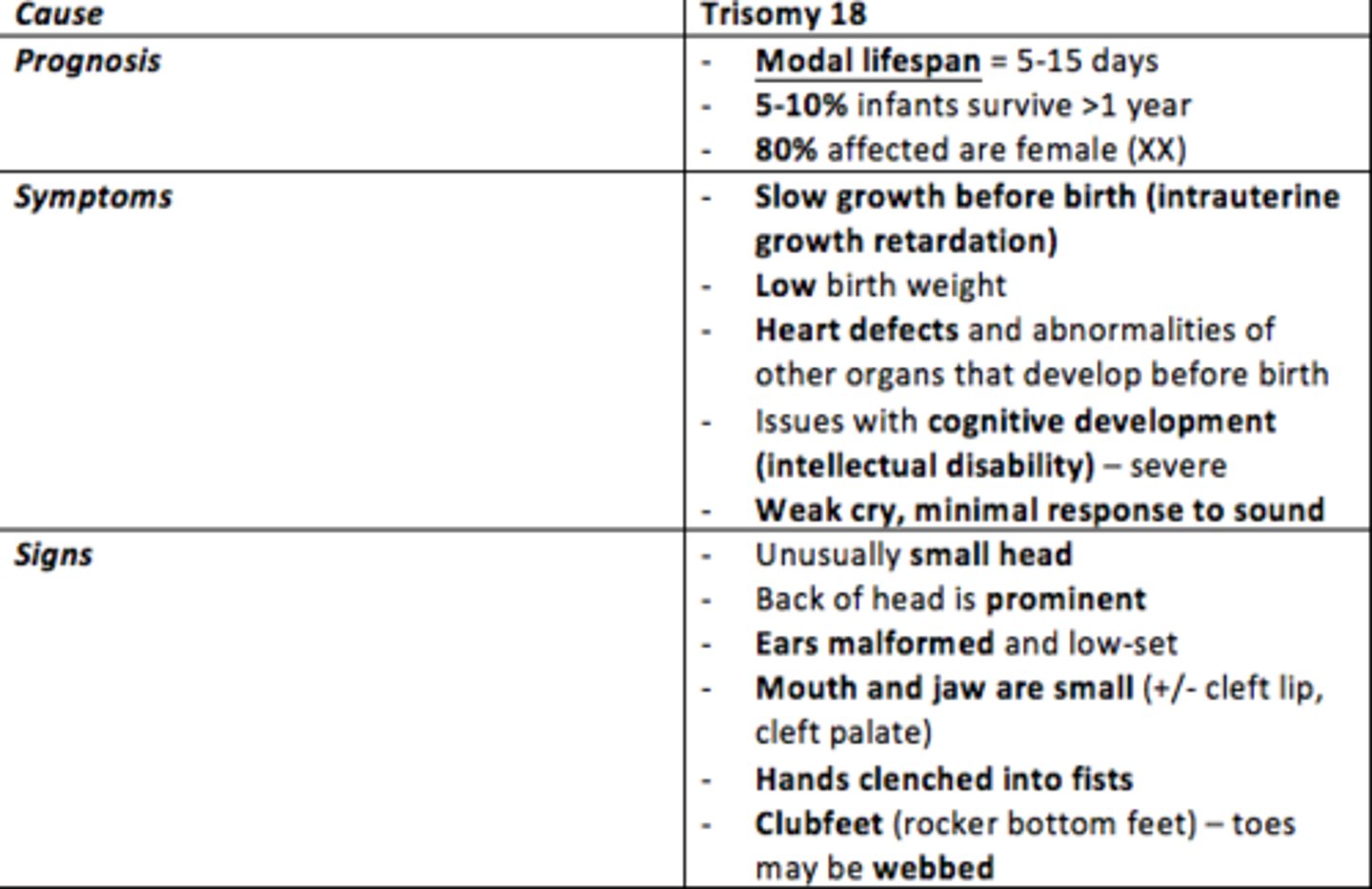
What are some symptoms of Edward's syndrome?
- Intrauterine growth retardation = slow growth before birth
- Low birth weight
- Heart defects
- Severe intellectual disability
- Weak cry & minimal sound response
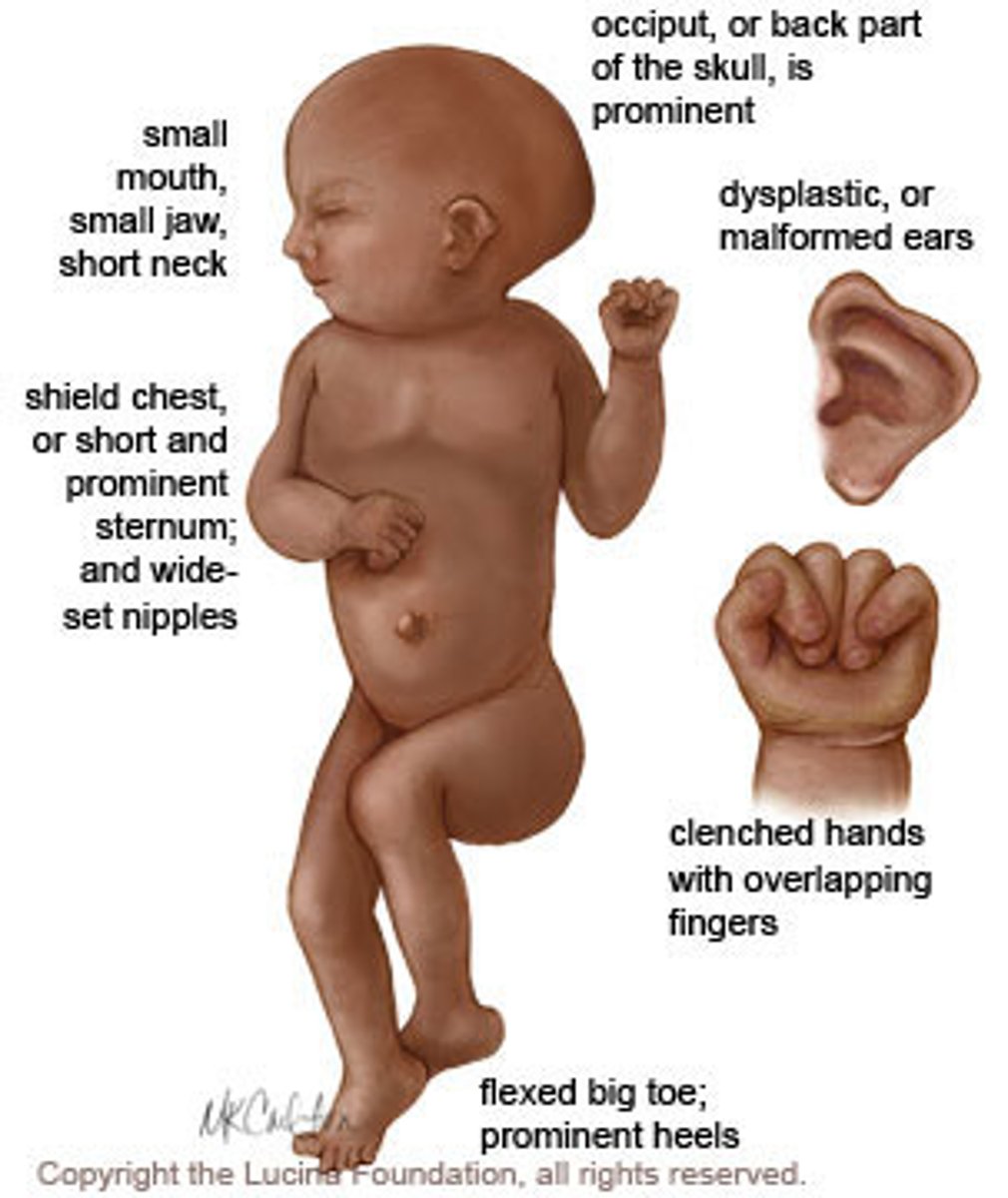
What are some visible characteristics (common features) in Edward's syndrome?
- Unusually small head
- Prominent back of head
- Ears malformed and low-set
- Small mouth & jaw +/- cleft lip palate
- Hands clenched into fists
- Clubfeet/rocker-bottom feet +/- webbed toes
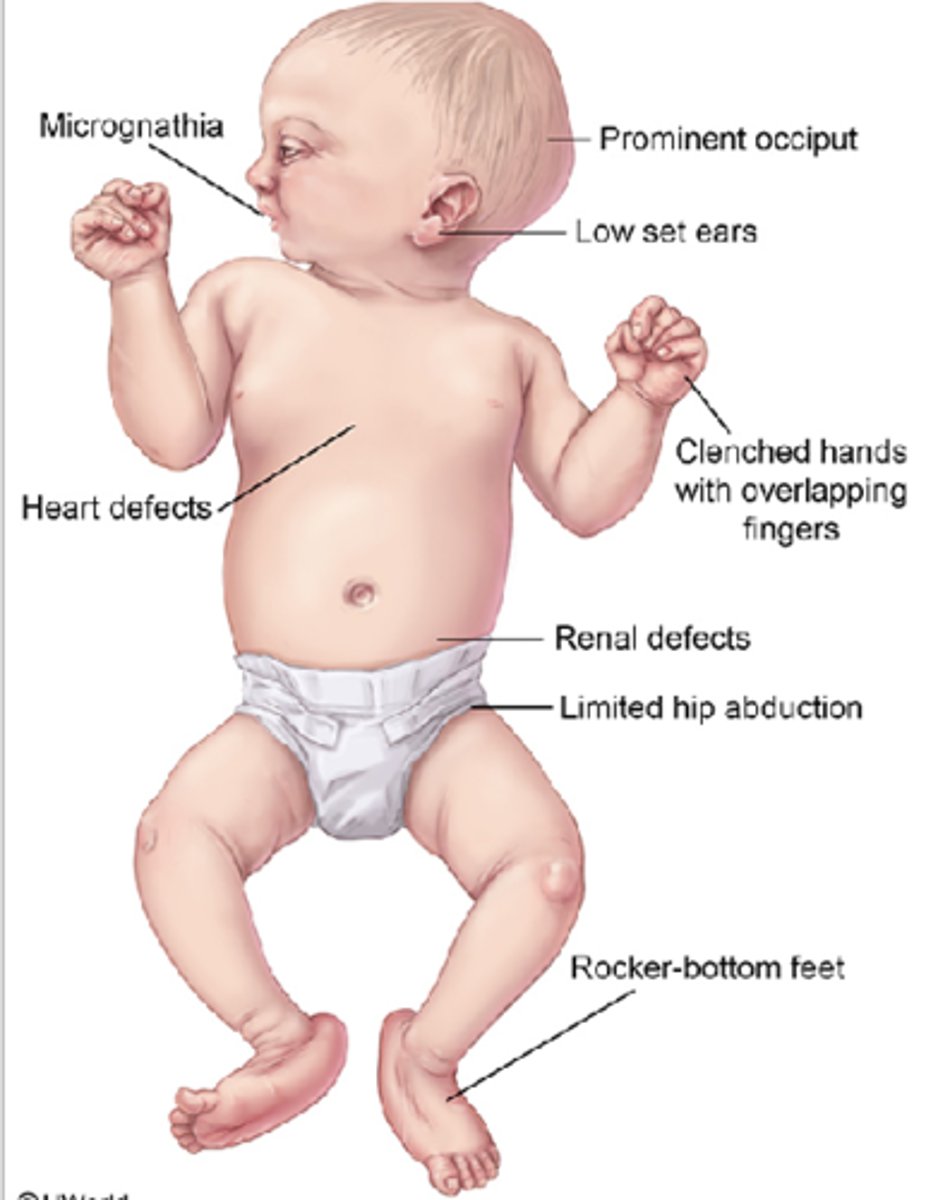
What is Patau syndrome?
An example of an autosomal aneuploidy (trisomy 13).
44,XX,+13

What are the symptoms of Patau syndrome?
- Severe intellectual disability
- Congenital heart defects
- CNS abnormalities (brain and spinal cord)
- Very small, poorly developed eyes = microphthalmia
- Low-set ears
- Extra fingers/toes 'polydactylyl'
- Cleft-lip/cleft-palate
- Hypotonia
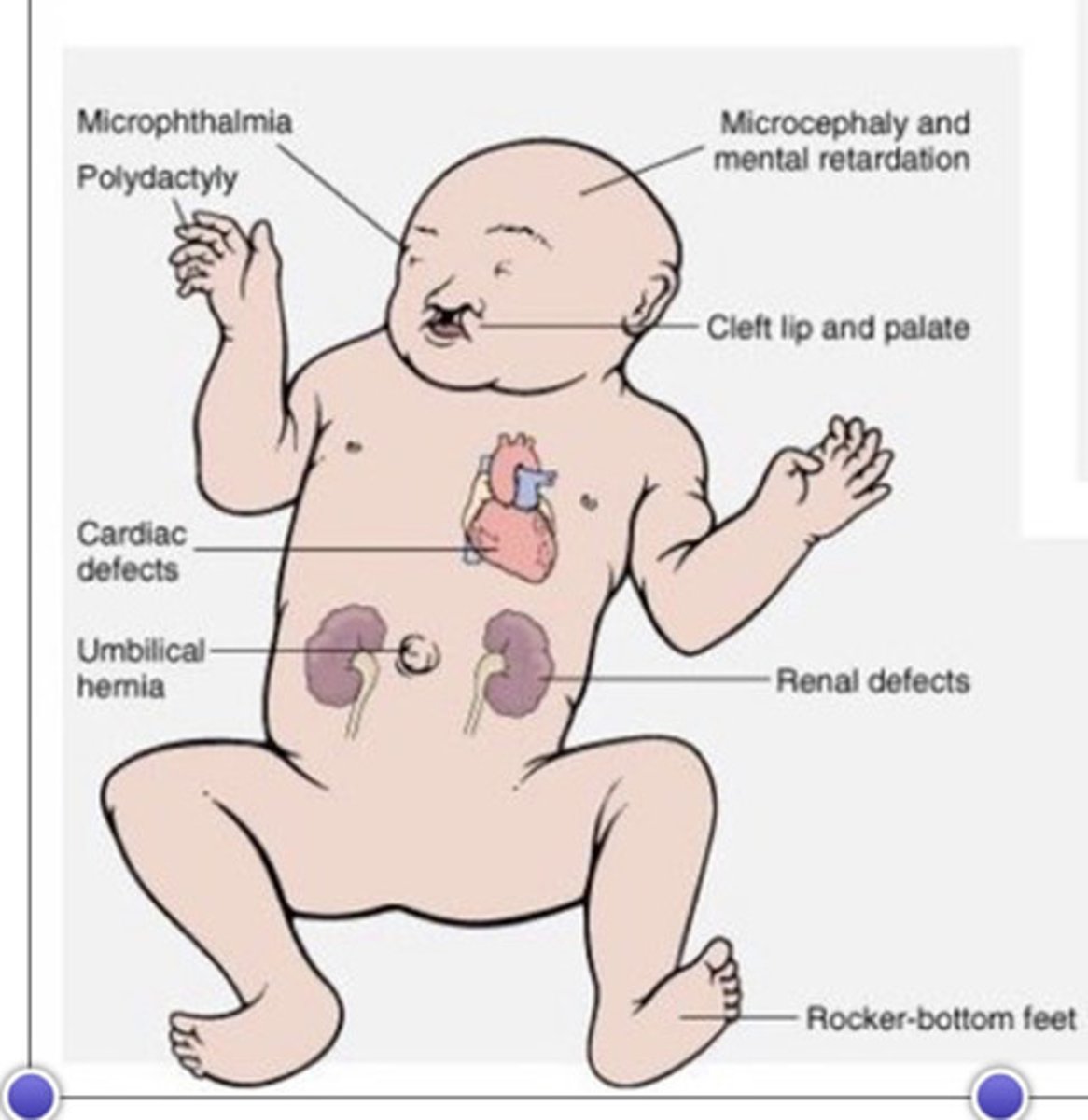
Why are humans more able to tolerate sex chromosome aneuploidy than autosomal chromosome aneuploidy?
This tolerance most likely relates to:
1) X-inactivation
2) Small number of genes on the Y chromosome
Give some examples of sex chromosome aneuploidy disorders
- Turner syndrome 45, X
- Triple X syndrome 47, XXX
- Klinefelter syndrome 47,XXY
- XYY syndrome 47,XYY

What is x-chromosome inactivation?
A process when one of the two X chromosomes is randomly "turned off" via transcriptional silencing.
This is also called 'lyonization' - named after Mary F. Lyon.
Once establised, inactivation is STABLE - same X chromosome remains inactivated in all subsequent cell generations - each female is a MOSAIC of cells in which either maternally inherited or paternally inherited X is silenced.
What is a Barr body?
an inactivated X chromosome in a cell with more than one X chromosome

What is Turner Syndrome?
Occurs in females when they only have one X chromosome.
Sex chromosome aneuploidy
45,X karyotype
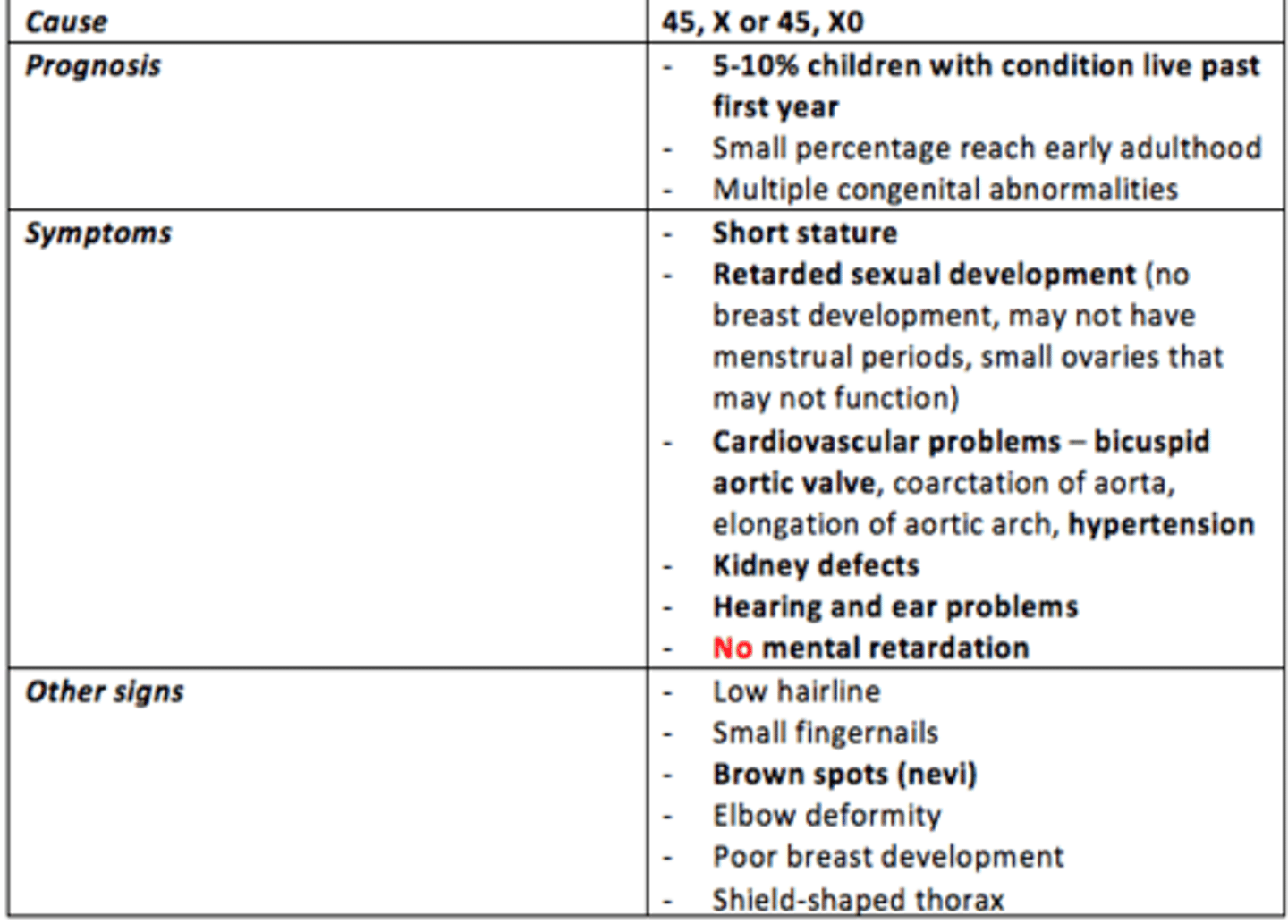
What are the symptoms of Turner syndrome?
1) Short stature
2) Retarded sexual development
3) Cardiovascular problems (bicuspid aortic valve, coarctation of aorta, elongation of aortic arch, hypertension)
4) Kidney defects (30-40%)
5) Hearing problems (>50% adults)
6) No mental retardation
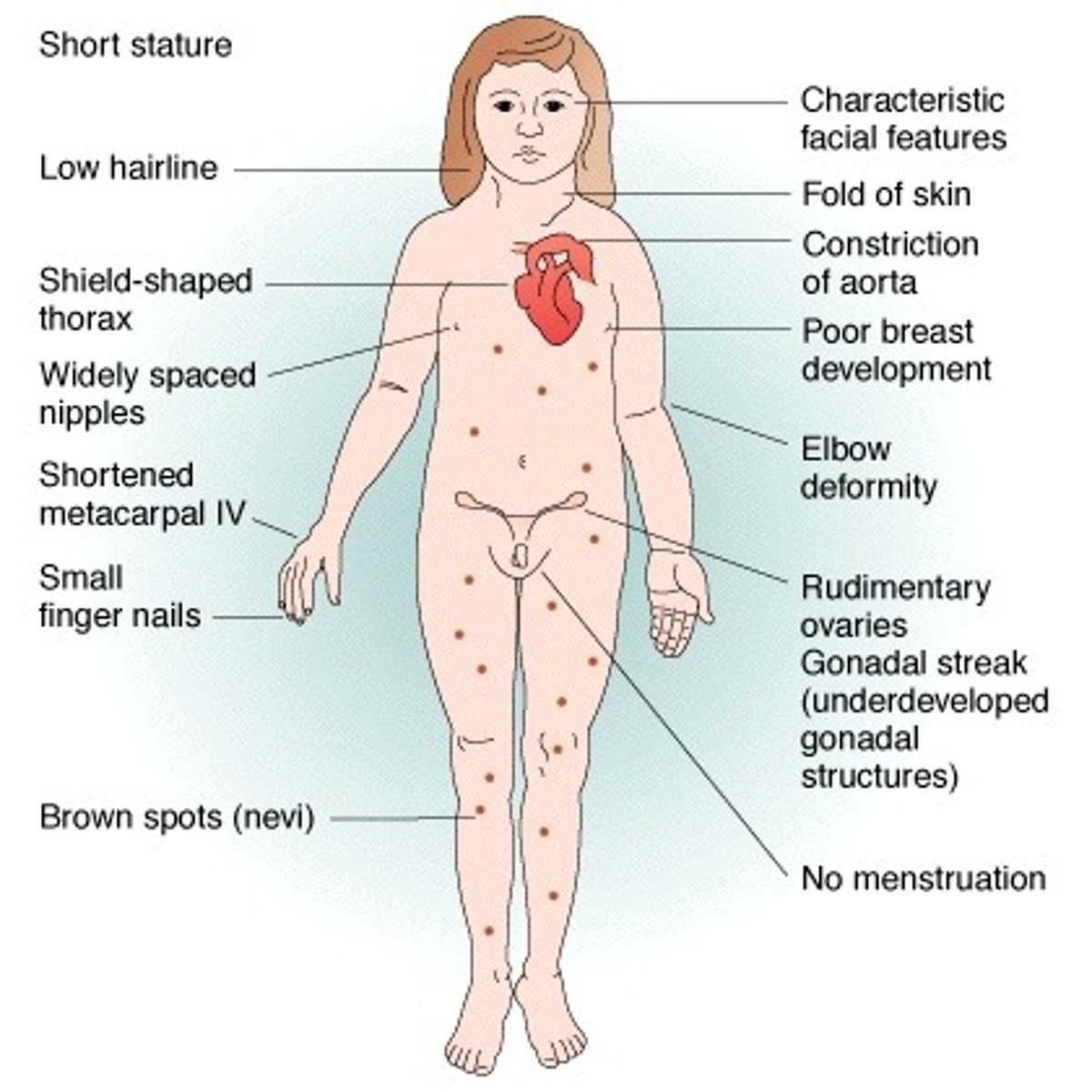
What is triple X syndrome?
47, XXX karyotype
A syndrome with 3 X chromosomes which is sometimes not detected but can cause sterility and intellectual traits (mild)
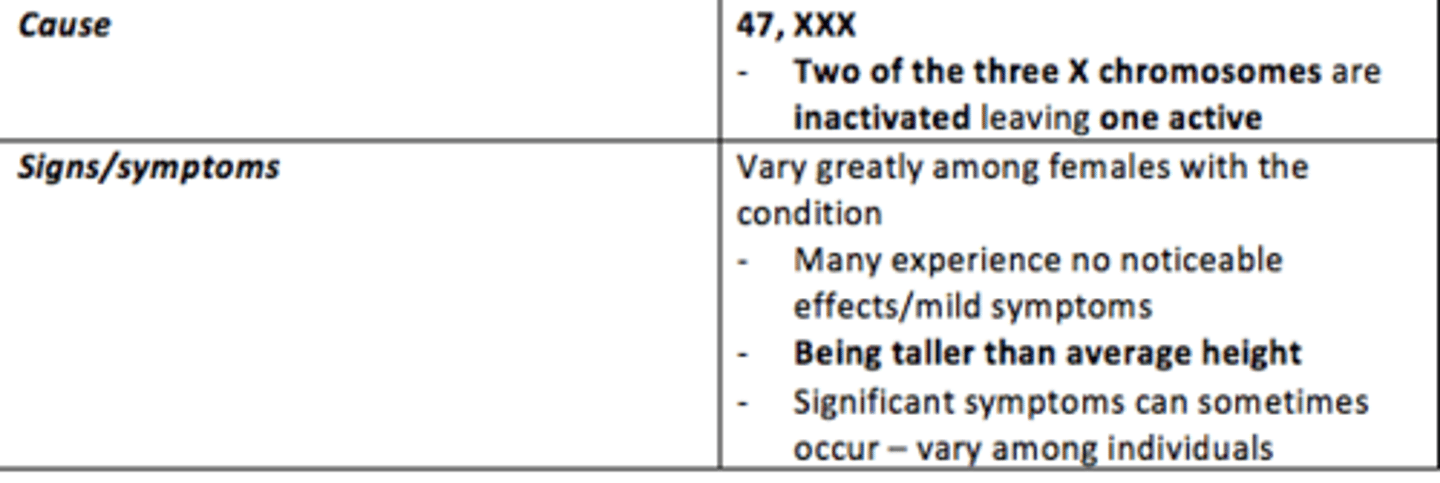
How many of the X chromosomes in triple X syndrome are inactivated?
Two of the three X chromosomes are inactivated, leaving one X chromosome active
What is the most common physical feature of triple X syndrome?
Being taller than average height
What is Klinefelter syndrome?
What are the most common physical features?
47, XXY karyotype
Most common physical feature: taller & less muscular body than average males and gynecomastia

What is XYY syndrome?
47, XYY karyotype
Most common feature: taller (~7cm taller than average), slightly lower IQ but normal intelligence

What is chromosomal translocation?
When part of one chromosome is mistakenly attached to another chromosome
What is a Robertsonian translocation?
A chromosomal translocation mutation
- Breakage of two acrocentric chromosomes (number 13, 14, 15, 21, 22) at or close to their centromere
- Subsequent fusion of their long arms (q) to form one chromosome
- Total chromosome number reduced to 45
What is the most common fusion in Robertsonian translocation?
The most common fusion is between chromosome 13 and 14.
Are Robertsonian translocation carriers symptomatic?
No, often asymptomatic
Do Robertsonian translocation carriers produce balanced gametes?
No, Robertsonian translocation carriers produce unbalanced gametes which can lead to = monosomic or trisomic zygotes.
What is the Philadelphia chromosome translocation?
Occurs in chronic myeloid leukemia (CML).
Reciprocal translocation between chromosome 9 and 22 - causing a fusion gene (BCR-ABL) that encodes for a fusion protein BCR-ABL that is oncogenic.
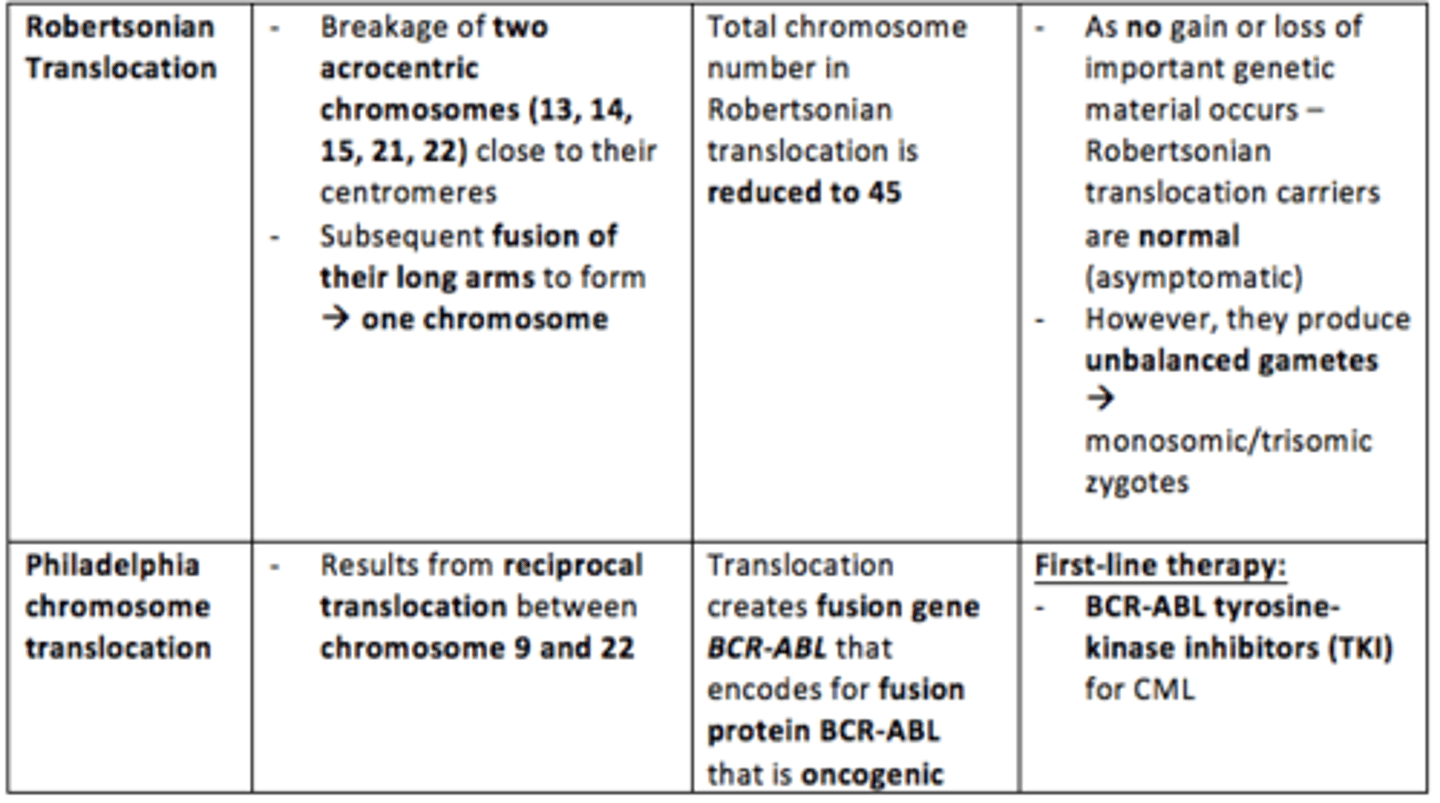
What is standard therapy for CML patients (philadelphia chromosome translocation)?
BCR-ABL tyrosine kinase inhibitors (TKI) is first-line therapy for most CML patients
What are terminal and interstital deletions of chromosomes?
Regions of chromosomes can become deleted internally (interstitally) or at the ends (terminally) by breakage.
- Such deletions will ALWAYS be unbalanced with an associated phenotype.

What is an example of a condition caused by a deletion of the short arm of chromosome 17 (17p)
Chronic Lymphocytic Leukaemia (CLL)
What is an example of a cytogenic localization technique (method for visualising chromosomes)?
Fluorescence in situ hybridization (FISH)
What is FISH?
Fluorescence in situ hybridization: produces a fluorescent signal (red) at sites of specific DNA sequences. Several PROBES (each corresponding to specific genomic segment) can be simultaneously analysed and ordered with respect to eachother using multicolour FISH.
Why is FISH useful?
FISH is useful because...
1) Locates specific DNA sequences using fluorescence
2) Diagnosis of genetic diseases
3) Gene mapping
4) Detects CRYPTIC or submicroscopic abnormalities in INTERPHASE NUCLEI
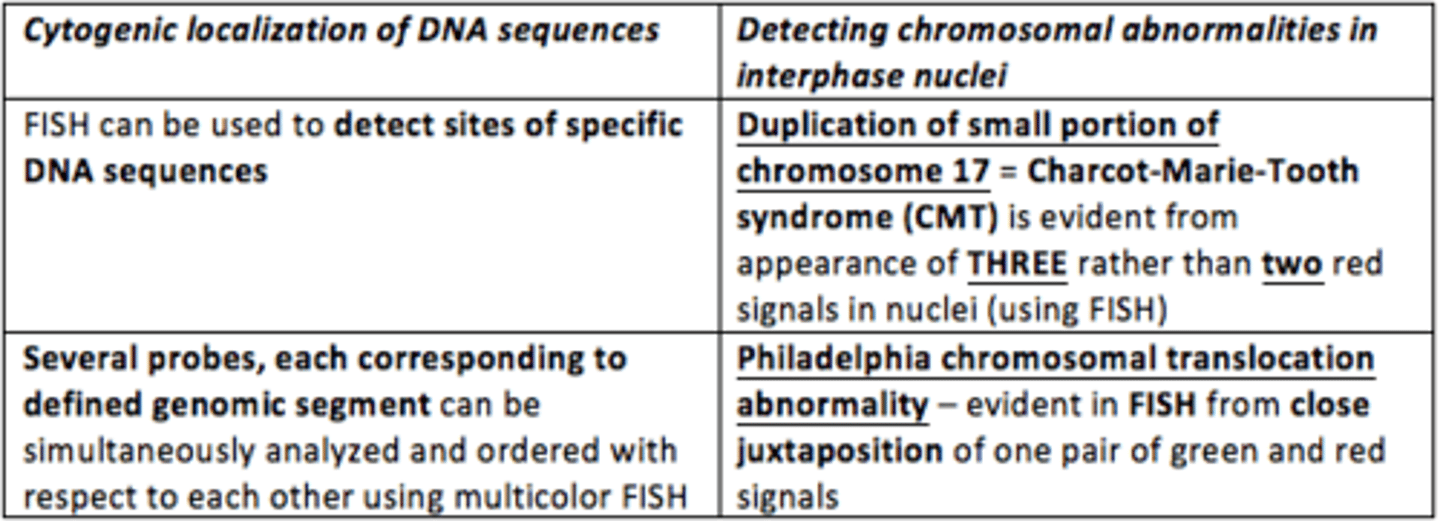
What are examples of conditions that can be visualised using FISH techniques?
1) Duplication of small portion of chromosome 17 = Charcot Marie Tooth syndrome
2) Philadelphia chromosome translocation = CML
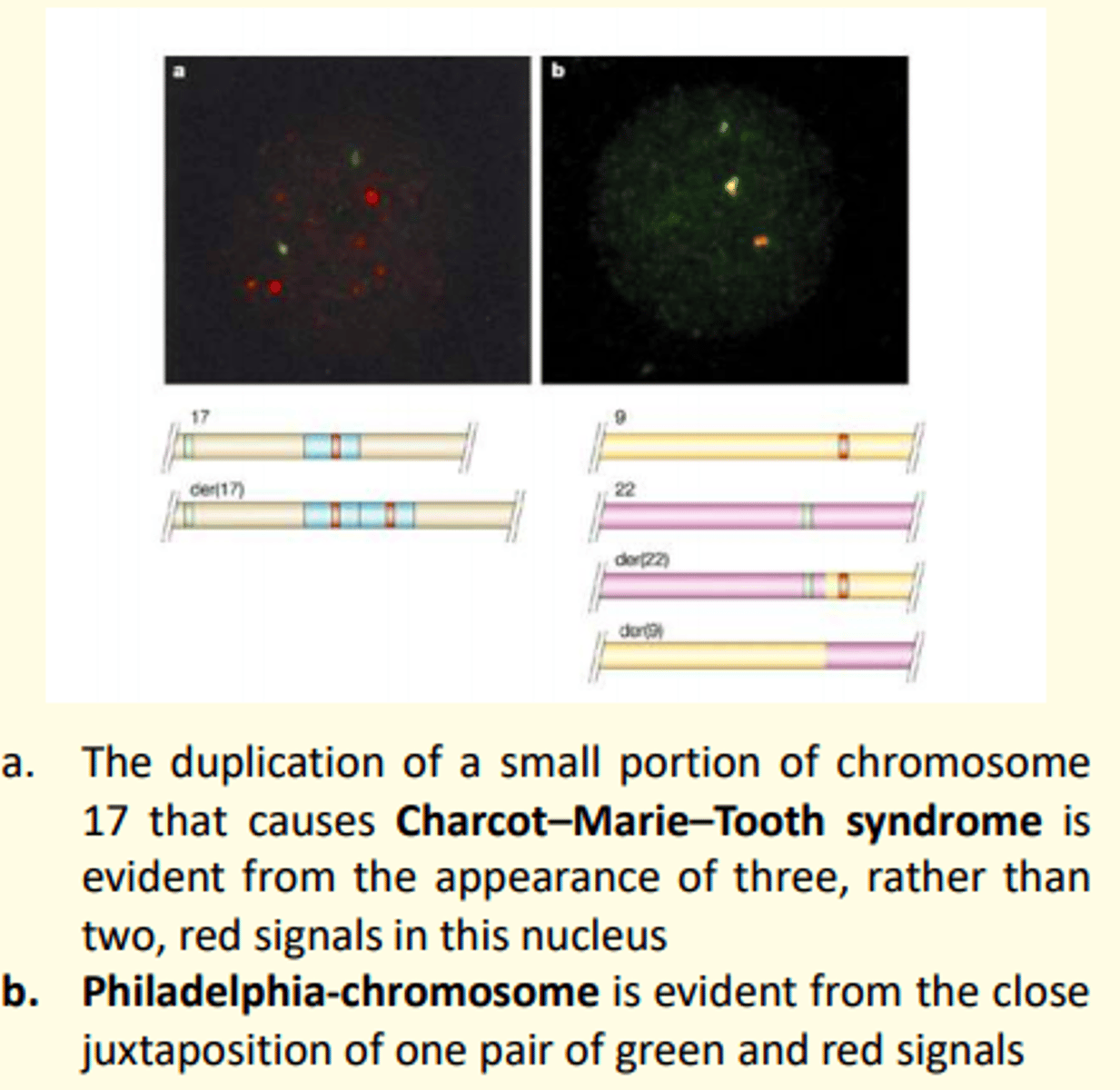
State the karyotype of a child (female) born to Down's syndrome (trisomy 21)
47,XX,+21
Describe what you would expect to see with a normal foetus' karyotype?
On a standard karyotype, you would expect to see pictures of pairs of chromosomes 1-22 and a pair of X chromosomes.
What is the name of the phenomenon seen in this image of a dividing human cell in late anaphase/early telophase
Anaphase lag = chromosomes are separated to opposite ends of cell, however, there are still a few chromosomes in the centre of the cell - which is unusual. The cell shows early signs of invagination and is about to divide into two daughter cells.
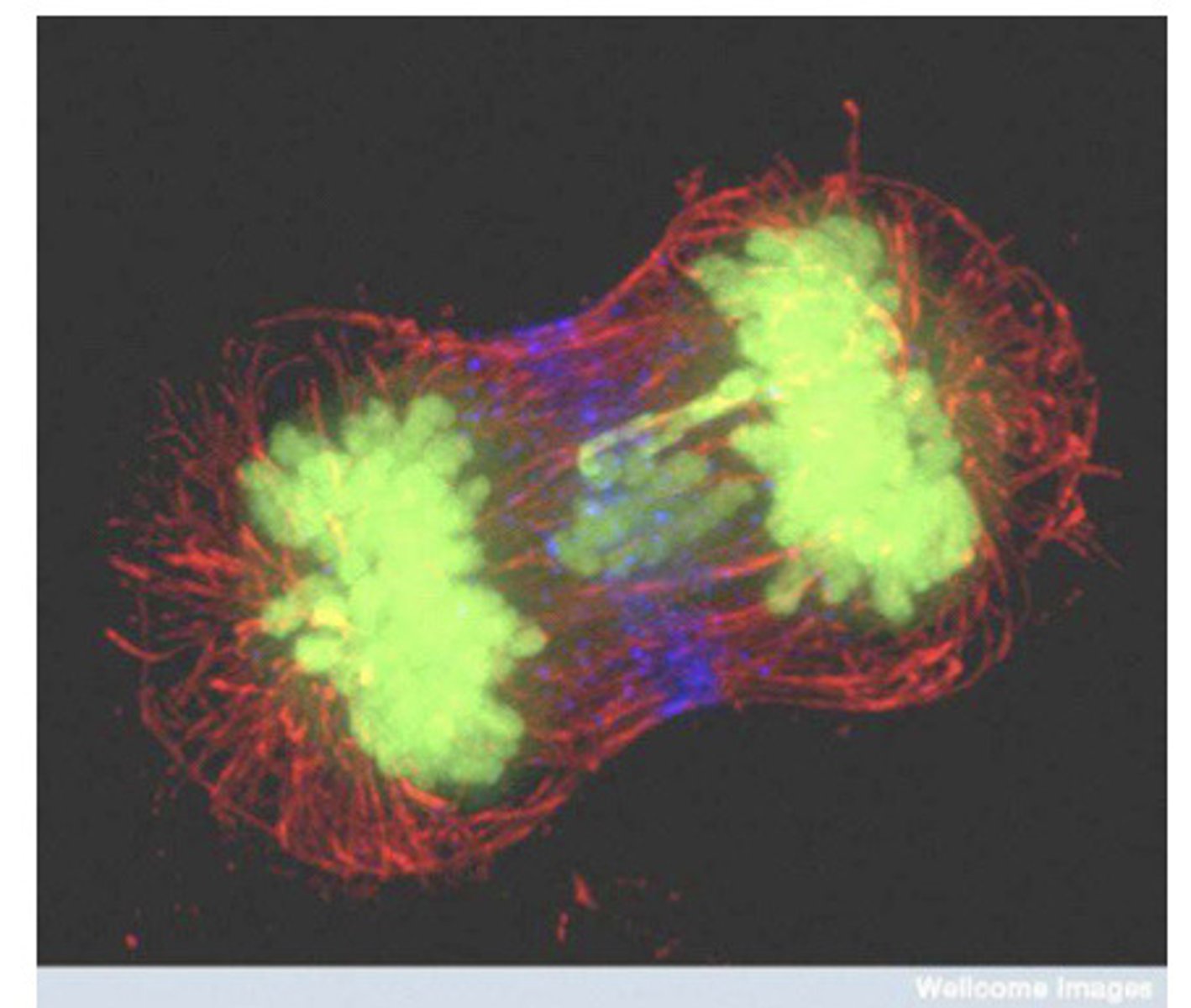
What types of investigations could you conduct to find out more about an individual's chromosome abnormality?
1. Comparison of individual's karyotype with one of a healthy individual
2. Different staining (giemsa) of patient's karyotype to look at the banding patterns in detail
3. FISH experiments with probes for specific genes
Looking at the karyotype below - diagnose the patient's condition...
45, X = Turner syndrome
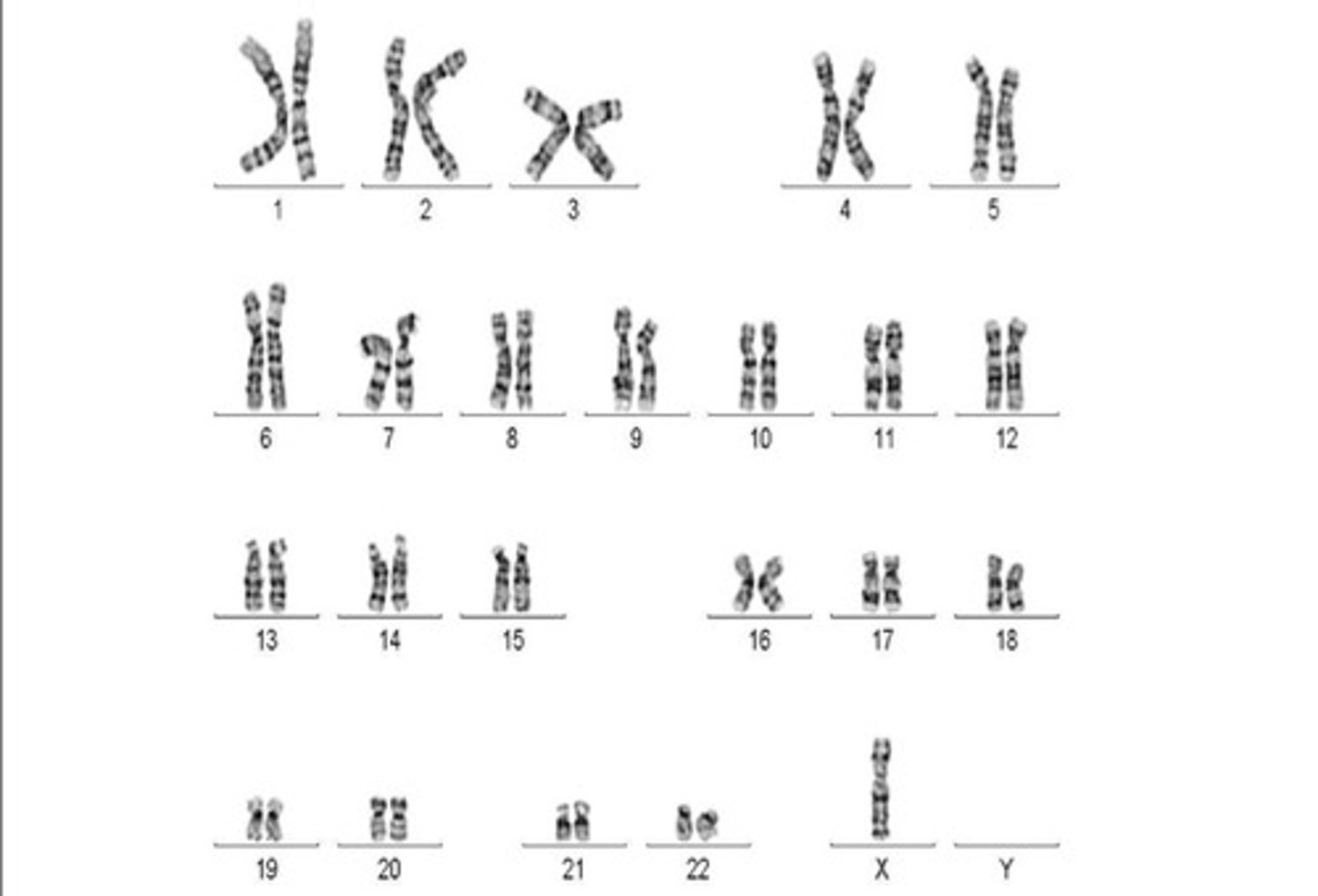
What condensed structures, visible with light microscopy, are inactivated X-chromosomes found within nucleus of the cell?
Barr bodies
State the two primary mechanism in which a trisomy or monosomy can be produced with gametogenesis or the early mitotic divisions of the embryo…
1. Non-disjunction: failure of homologous chromosomes or sister chromatids to separate properly during cell division
2. Anaphase lag: a delayed moment during anaphase where one homologous chromosome in meiosis or one chromatid in mitosis fails to connect to the spindle apparatus, or is tardily drawn to its pole and fails to be included in the reforming nucleus
Identify the following features of the epididymis by labelling the arrows
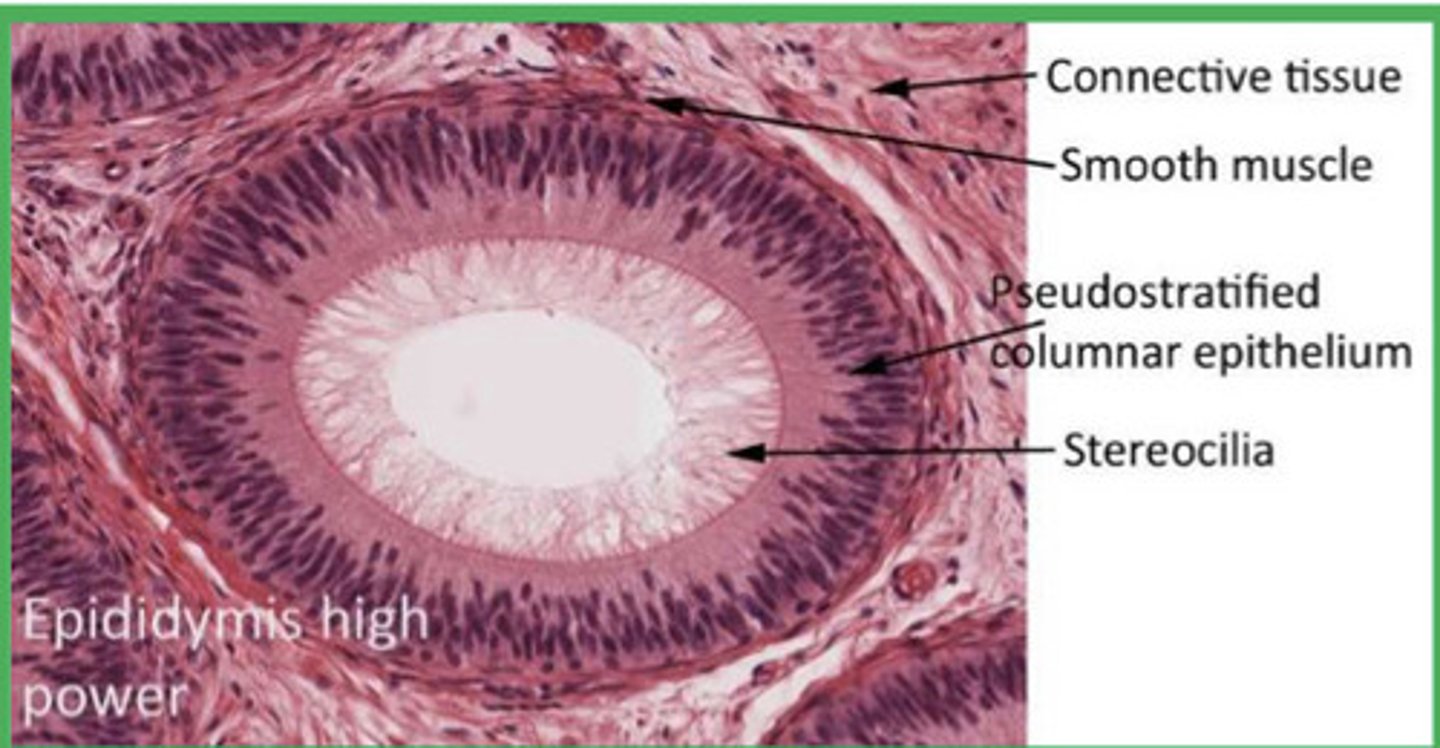
What are common reasons someone may be referred for genetic counselling?
1) Positive family history for specific inherited disease
2) Pregnant women of higher age (increased risk of chromosomal abnormality)
3) Post-natal counselling available for individuals with infants with a genetic disorder or couples with multiple miscarriages
4) People exposed to high risks for genetic mutation - chemical, physical, viral
Describe how a chromosomal abnormality can occur during oogenesis
Anaphase lag leading to monosomy or trisomy in fertilised foetus.
Non-disjunction leading to monosomy or trisomy in fertilised foetus.
Robertsonian transolcation leading monosomy or trisomy.
Deleting of genetic material while crossing over..
What is the clinical term for this karyotype 47,XY,+13
Patau syndrome
Multiplex in situ hybridization (M-FISH)
24-color karyotyping technique and method of choice for studying complex interchromosomal rearrangements